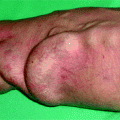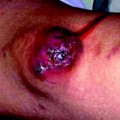Luc Turmel-Rodrigues and Claude J. RenaudDiagnostic and Interventional Radiology of Arteriovenous Accesses for Hemodialysis201310.1007/978-2-8178-0366-1_14© Springer-Verlag France 2013
14. Complications During and After Vascular Access Endovascular Procedures
(1)
Department of Vascular Radiology, Clinique St-Gatien, 8 place de la cathédrale, 37000 Tours, France
(2)
Department of Vascular Radiology, Clinique Ambroise Paré, 25 boulevard Victor Hugo, 92200 Neuilly-sur-Seine, France
(3)
Department of Medicine, Khoo Teck Puat Hospital, Alexandra Health, 90 Yishun Central, Singapore, 768828, Singapore
Abstract
Serum potassium level and fluid overload are the first elements to verify whenever a general clinical complication develops in a dialyzed patient. A glycemic test is equally important prior to any intervention in diabetics. The blood pressure may be extremely elevated (> 200 mmHg systolic). An oral antihypertensive, like sublingual captopril, is preferred and is largely effective at a gradual control of blood pressure. Restlessness, hypotension, and desaturation within minutes of contrast injection should always invoke the possibility of an anaphylactic reaction to iodinated contrast. Chest pain or discomfort immediately after the procedure should prompt a search for myocardial ischemia. However, disproportionate and precipitous chest pain during the procedure may be due to a hemopericardium resulting from guidewire tip-induced injury to the right atrium. Venous rupture during dilation is not an uncommon occurrence, but its management is usually easy. Hand ischemia can develop after overdilation of stenoses or should prompt a search for an iatrogenic embolus, not to mention an arterial dissection. There are rarer complications like paradoxical cerebral ischemia, fluid overload after dilation of a central vein stenosis, local infection or systemic bacteremia, and pseudoaneurysms at cannulation zones or in freshly dilated areas.
Stay updated, free articles. Join our Telegram channel

Full access? Get Clinical Tree






